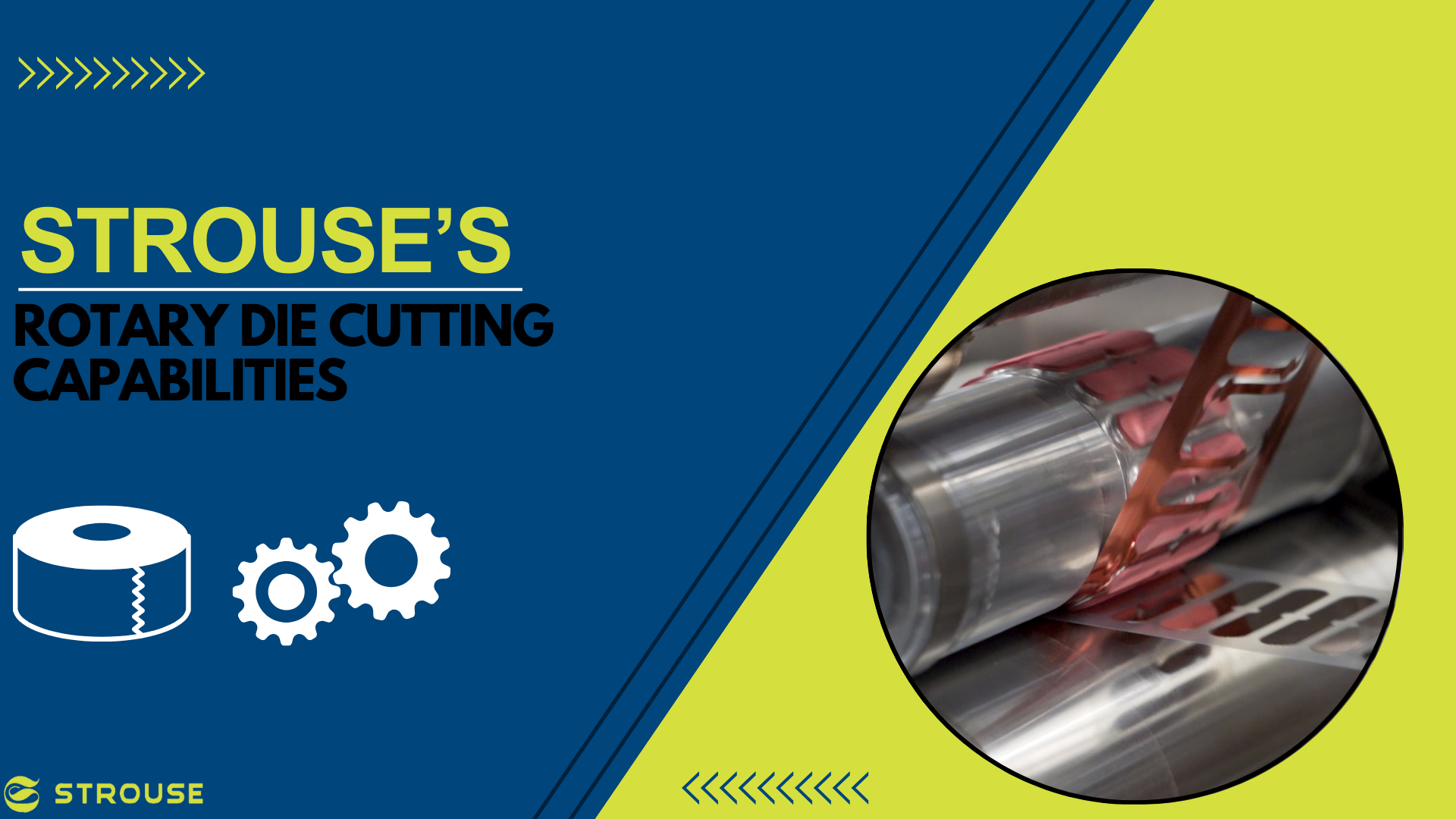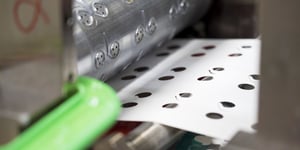The US craft industry is worth over $44 billion USD.
If you've contributed to this booming economy, then it's likely that you've used die cutting services before in your arts and crafts- or at least have heard of them before.
However, you may not know that die cutting isn't solely for creative pursuits. As a flexible material converter, Strouse has used rotary die cutting as a tool with many applications across essential industries like health care, aerospace, and even the military.
One of the most efficient means of die cutting in these professions is rotary die cutting, and using these services can make the lives of doctors, engineers, and many others a whole lot easier. But how is this possible?
Today, you’re going to gain an understanding of rotary die cutting, including what it is, how it works, and how it benefits you regardless of your product or industry.
THE BASICS OF DIE CUTTING
Generally, a die is a tool used to cut material into a given shape.
Die tools, commonly custom-built from metal, cut through surfaces like paper, fabric, adhesive, and foam to create the desired shape. They can make many cuts of cloth or plastic that are identical in size and shape to one another.
In the 1800s, shoemakers created sets of leather shoes using a die tool to cut identical shoe shapes from a larger leather sheet. Nowadays, this process involves die cutting machines that can slice through different materials to produce multilayered or otherwise complex parts at a fast rate.
What Is Rotary Die Cutting?

As you may have guessed, rotary motion refers to a circular movement around a singular turning point.
Rotary die cutting is a special kind of die cutting that uses a cylindrical die to cut shapes out of material. It moves around and around in a circular motion and has blades to cut out the desired shape around the entirety of the cylinder. The die cutting process is incredibly efficient because it cuts out many identical shapes as it rotates.
Die cut press machines require many minor adjustments before they’re ready to run, which can lead to a longer setup time. After setup, the operator is responsible for restocking the material of the rotary machine and monitoring the progress of the parts.
Rotary die cutting is ideal for many engineering industries, where metal, plastic, or adhesive components must be precisely the same size for a piece of equipment to work.
ROTARY VS FLATBED VS LASER DIE CUTTING
If you've heard of flatbed or laser die cutting before, it's crucial to understand how rotary die cutting differs from them.
Rotary die cutting is different from flatbed and laser die cutting. While rotary die cutting uses a cylinder die tool to cut shapes out of a material, flat bed die cutting uses a hydraulic flat bed press to cut your desired shape out of the material.
Flat bed die cutting is suitable for low-volume projects, yet inefficient for high-volume ones, whereas rotary die cutting machines can often perform many more cuts.
Laser die cutting differs entirely from flatbed and rotary die cutting: rather than steel, it uses a laser to create the desired shape. The light from the laser sears into the materials and produces a variety of shapes. While laser die cutting is efficient for some materials, others react poorly to the light and may be destroyed.
Different projects benefit from using particular cutting methods, and flexible material converters often offer suggestions on a type that suits your unique design.
WHAT MATERIALS CAN YOU ROTARY DIE CUT?
Rotary die cutting can cut a wide variety of materials, so wide in fact, it’s difficult to describe which flexible materials we can die cut.
Most flexible material converters provide services in cutting foam tape, industrial tape, medical adhesive, masking tape, thermal interface, surface protection, and others.
Converters CAN cut most flexible materials, but achieving tight die cut tolerances on elastic, abrasive, thick, or unsupported materials is more challenging (and expensive).
When Do You Use Rotary Die Cutting?
From hydrocolloid bandages to O-ring gaskets, rotary die cutting increases speed and consistency in several industries. We will discuss more specific uses and instances of rotary die cutting.
CREATIVE PURSUITS
Die cutting– particularly that of adhesive and paper– is essential in many creative pursuits.
Suppose you make a living working in graphic design, interior decorating, or creating yearbooks or scrapbooks in bulk. In that case, you will likely need die cuts that adhere to your project. Otherwise, it would be challenging to produce logos, wallpaper, or book cover surface protectors– especially when you want multiple ones in identical sizes.
MEDICAL TOOLS AND WOUND CARE
Rotary die cutting for adhesive can solve a wide variety of problems in the medical field.
Medical adhesive tape is one of the most used tools in the medical industry because it's versatile and used to solve many complex and prevalent issues.
Rotary die cutting machines can cut many materials for adhesive medical tape, including waterproof adhesive and durable cloth tape. These adhesive tapes are breathable, making them suitable for the skin of the person using them, and pressure-sensitive, meaning that no additional solvent or heat solution will be necessary.
Using a die cut is beneficial to medical tapes because it ensures that every piece is the correct size and shape to adhere directly to a patient's skin, thus healing the wound with as minimal discomfort as possible.
A common problem in the medical field is when adhesive tape adheres too closely to the skin, not allowing it to breathe. When you rotary die cut your own medical tape and other components, you ensure the parts coming off the machine are in whatever breathable materials you want.
SURFACE PROTECTION
Surface protection is an underrated component of most industries.
In the medical and scientific fields, surface protectors must be applied to tables over which experiments are performed. Engineers need to protect the machines they create, and of course, no one wants a dinged-up car because professionals in the automotive industry didn't think ahead far enough to use an adhesive that guards it against scratching and denting.
So how can these problems be solved? If you guessed 'rotary die cutting,' you're correct! Flexible material converters will create surface protection barriers in the perfect shape for cars or industrial machines using rotary die cutting.
THERMAL MASKING
Cold temperatures can create a variety of functionality problems.
Machines in factories or construction zones stop running when temperatures drop. In addition, places without appropriate insulation can create uncomfortable, or even unsafe, work environments for laborers.
To combat these effects, people often use thermal masking tape, which provides insulation and will stick to most surfaces with the right adhesive.
Rotary die cutting machines are great for cutting thermal masking tape so it adheres to any surface you like- machinery, car windshields, and even walls in buildings where labor takes place. Die cut thermal masking tape ensures that machines and people continue to function appropriately, even in frigid temperatures.
MILITARY & DEFENSE
Adhesive thermal tape for military equipment like gloves, helmets, and boots can keep soldiers warm. It can also coat weaponry such as tanks and assault rifles, protecting their surfaces through long-term wear by making items more resistant to harsh weather conditions or damage.
Rotary die cutting is a process that can be applied to nearly, if not every, industry. If you want to know more about how rotary die cutting can be used, check out rotary die cutting uses sorted by industry.
If you’re looking for identical components, rotary die cutting is a potential option for you.
Now is a good time to consider where you are in the process: are you planning a concept without a design? Or, have you already found material and design, and you’re seeking out prototypes? Product development isn’t always linear, but you’ll want to have some sort of drawing with measurements and an idea about the material before approaching an adhesive converter.
Got any questions? Feel free to check out our guide, or you can learn more about rotary die cutting and other processes in our Learning Center.
Originally published: January 6, 2020
.jpeg?width=290&name=0%20(1).jpeg)






